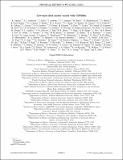Low-mass dark matter search with CDMSlite
Author(s)
Agnese, R.; Anderson, A. J.; Aralis, T.; Aramaki, T.; Arnquist, I. J.; Baker, W.; Balakishiyeva, D.; Barker, D.; Basu Thakur, R.; Bauer, D. A.; Binder, T.; Bowles, M. A.; Brink, P. L.; Bunker, R.; Cabrera, B.; Caldwell, D. O.; Calkins, R.; Cartaro, C.; Cerdeño, D. G.; Chang, Y.; Chagani, H.; Chen, Y.; Cooley, J.; Cornell, B.; Cushman, P.; Daal, M.; Di Stefano, P. C. F.; Doughty, T.; Esteban, L.; Fascione, E.; Figueroa-Feliciano, E.; Fritts, M.; Gerbier, G.; Ghaith, M.; Godfrey, G. L.; Golwala, S. R.; Hall, J.; Harris, H. R.; Hong, Z.; Hoppe, E. W.; Hsu, L.; Huber, M. E.; Iyer, V.; Jardin, D.; Jastram, A.; Jena, C.; Kelsey, M. H.; Kennedy, A.; Kubik, A.; Kurinsky, N. A.; Loer, B.; Lopez Asamar, E.; Lukens, P.; MacDonell, D.; Mahapatra, R.; Mandic, V.; Mast, N.; Miller, E. H.; Mirabolfathi, N.; Moffatt, R. A.; Mohanty, B.; Morales Mendoza, J. D.; Nelson, J.; Orrell, J. L.; Oser, S. M.; Page, K.; Page, W. A.; Partridge, R.; Pepin, M.; Peñalver Martinez, M.; Phipps, A.; Poudel, S.; Pyle, M.; Qiu, H.; Rau, W.; Redl, P.; Reisetter, A.; Reynolds, T.; Roberts, A.; Robinson, A. E.; Rogers, H. E.; Saab, T.; Sadoulet, B.; Sander, J.; Schneck, K.; Schnee, R. W.; Scorza, S.; Senapati, K.; Serfass, B.; Speller, D.; Stein, M.; Street, J.; Tanaka, H. A.; Toback, D.; Underwood, R.; Villano, A. N.; von Krosigk, B.; Welliver, B.; Wilson, J. S.; Wilson, M. J.; Wright, D. H.; Yellin, S.; Yen, J. J.; Young, B. A.; Zhang, X.; Zhao, X.; Leder, Alexander Friedrich; ... Show more Show less
DownloadPhysRevD.97.022002.pdf (4.097Mb)
PUBLISHER_POLICY
Publisher Policy
Article is made available in accordance with the publisher's policy and may be subject to US copyright law. Please refer to the publisher's site for terms of use.
Terms of use
Metadata
Show full item recordAbstract
The SuperCDMS experiment is designed to directly detect weakly interacting massive particles (WIMPs) that may constitute the dark matter in our Galaxy. During its operation at the Soudan Underground Laboratory, germanium detectors were run in the CDMSlite mode to gather data sets with sensitivity specifically for WIMPs with masses <10 GeV/c[superscript 2]. In this mode, a higher detector-bias voltage is applied to amplify the phonon signals produced by drifting charges. This paper presents studies of the experimental noise and its effect on the achievable energy threshold, which is demonstrated to be as low as 56 eV[subscript ee] (electron equivalent energy). The detector-biasing configuration is described in detail, with analysis corrections for voltage variations to the level of a few percent. Detailed studies of the electric-field geometry, and the resulting successful development of a fiducial parameter, eliminate poorly measured events, yielding an energy resolution ranging from ∼9 eV[subscript ee] at 0 keV to 101 eV[subscript ee] at ∼10 keV[subscript ee]. New results are derived for astrophysical uncertainties relevant to the WIMP-search limits, specifically examining how they are affected by variations in the most probable WIMP velocity and the Galactic escape velocity. These variations become more important for WIMP masses below 10 GeV/c[superscript 2]. Finally, new limits on spin-dependent low-mass WIMP-nucleon interactions are derived, with new parameter space excluded for WIMP masses ≲3 GeV/c[superscript 2].
Date issued
2018-01Department
Massachusetts Institute of Technology. Department of PhysicsJournal
Physical Review D
Publisher
American Physical Society
Citation
Agnese, R., et al. “Low-Mass Dark Matter Search with CDMSlite.” Physical Review D, vol. 97, no. 2, Jan. 2018. © 2018 American Physical Society
Version: Final published version
ISSN
2470-0010
2470-0029